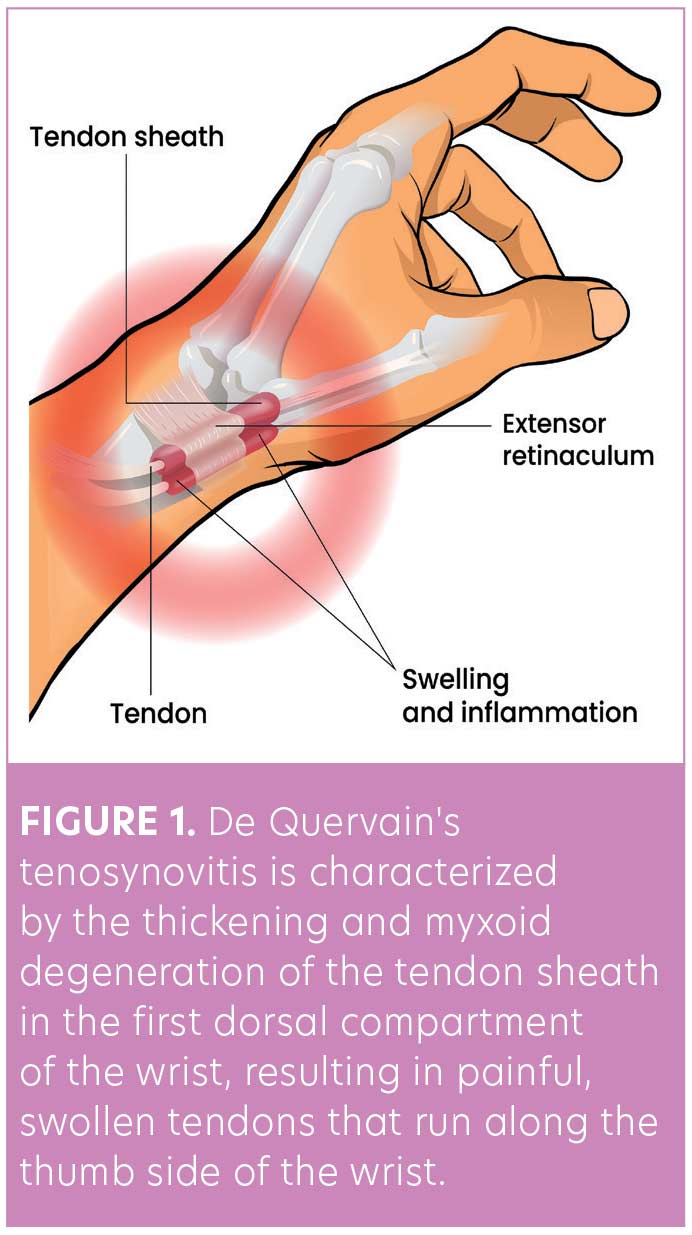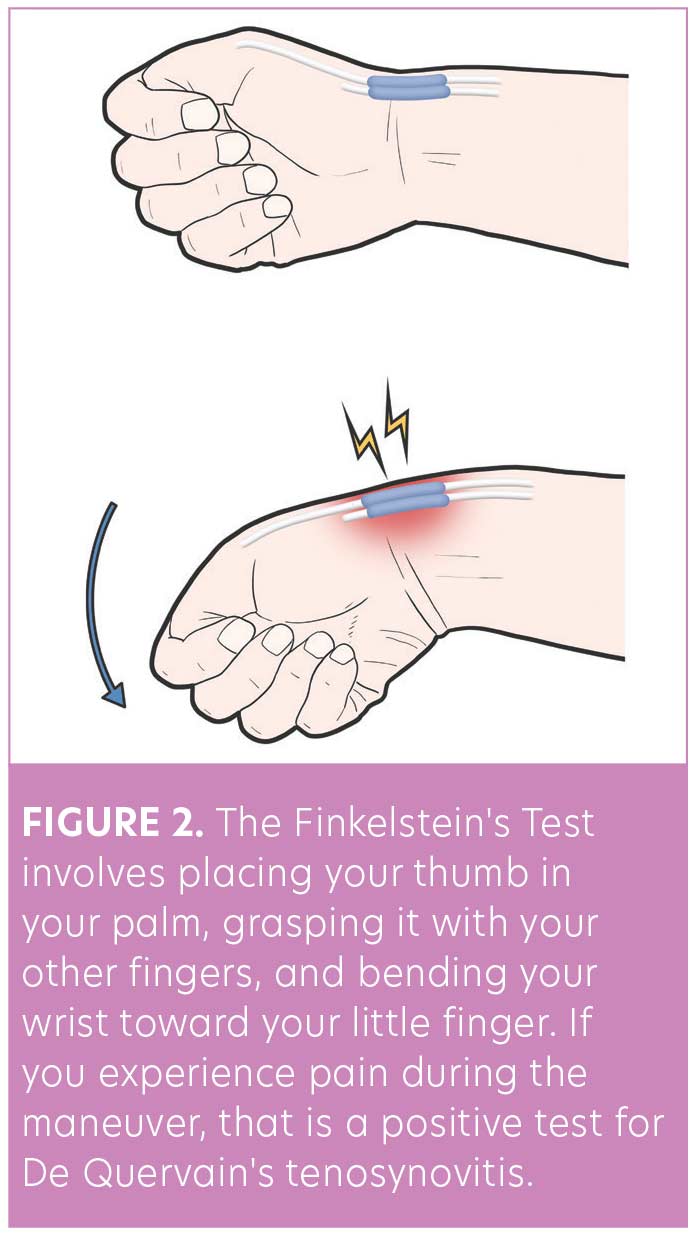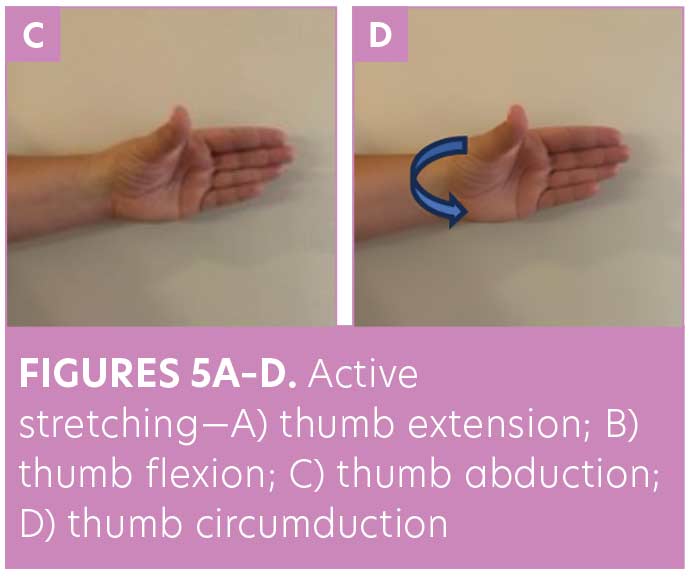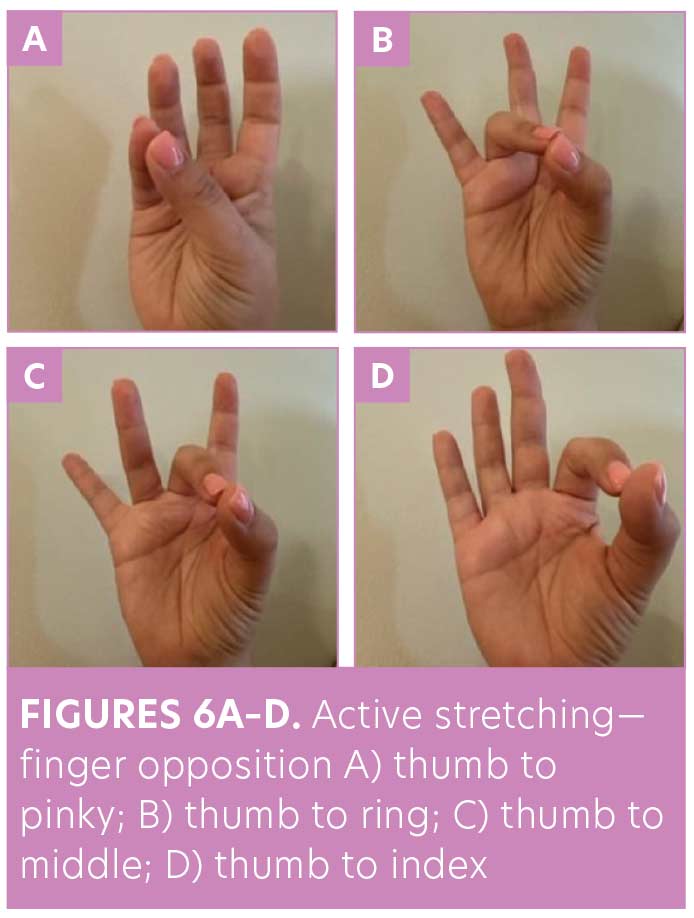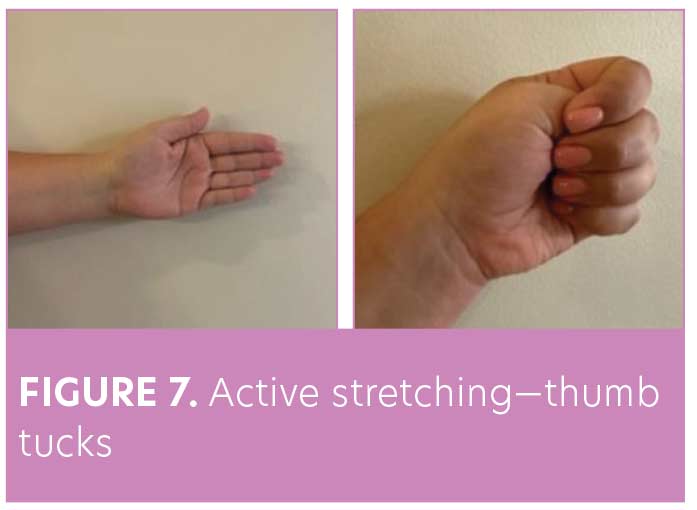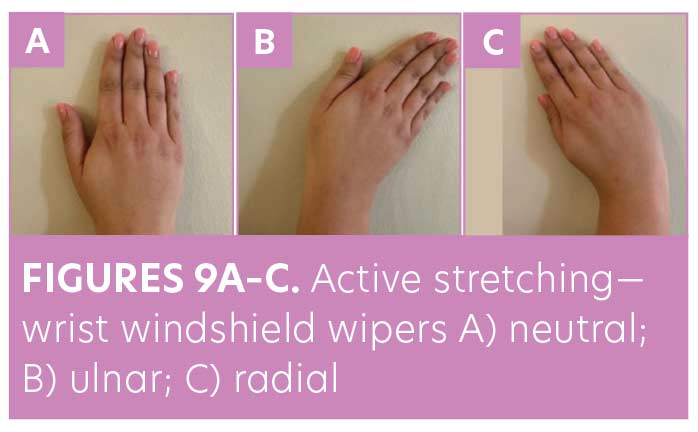 J Clin Aestet Dermatol 2023;16(9 Suppl 2):S28–S31
J Clin Aestet Dermatol 2023;16(9 Suppl 2):S28–S31
by Michele Rutkowski, APrN, FNP-C, and Kristy Rutkowski, OTR/L
Ms. M. Rutkowski is with Face Forward Aesthetics in Wexford, Pennsylvania. Ms. K. Rutkowski is with Positive Steps Therapy, LLC in Rochester, Pennsylvania.
FUNDING: The authors received no funding for this article.
DISCLOSURES: The authors report no conflicts of interest relevant to the content of this article.
ABSTRACT: Background. Aesthetics is a demanding and growing specialty. More providers are injecting daily at a high volume. De Quervain’s tenosynovitis (DQT) is a well-known syndrome involving the hand in the orthopedic and rehabilitation space. The prediction is that DQT will soon become well known to aesthetic injectors. DQT presents with swollen tendons that run along the thumb side of the wrist and attach to the base of the thumb. This is a result of repetitive motion or overuse of the thumb, most often of the dominant hand. This causes pain to the thumb and wrist area, making it difficult to complete daily tasks and perform injections on patients.
Objective. This article’s goal is to increase awareness among providers of the signs and symptoms of DQT and to be proactive in preventing this condition. A home exercise program has been created to focus on strengthening and conditioning the hand of injectors.
Methods. A systematic literature search of the PubMed database was completed.
Results. There is a positive correlation between industry demand, increased daily injecting, and the probability of injectors developing DQT. The pain caused by this syndrome can affect the daily lives and work performance of injectors. Proper body ergonomics, including stretching and strengthening the thumb, can be used to reduce pain caused by DQT.
Limitations. There was no case study or testing done on groups of people, which limits the results of this review.
Keywords: De Quervain tenosynovitis (DQT), Finklestein test, first dorsal compartment (FDC), abductor pollicis longus (APL), extensor pollicis brevis (EPB), nonsteroidal anti-inflammatory drugs (NSAIDs), physical therapy (PT), occupational therapy (OT), nurse practitioner (NP)
De Quervain’s tenosynovitis (DQT) is a well-known syndrome involving the hand in the orthopedic and rehabilitation space. As the field of aesthetics grows, this syndrome has become more prevalent among injectors, thus coining the phrase, “injector’s thumb.” Injectors should be aware of the signs and symptoms of DQT to address this condition as early as possible to prevent long-term pain and discomfort and other serious complications, which may require surgery. A table of exercises has been created to help injectors strengthen their dominant thumb to help avoid the pain of DQT.
Etiology
DQT is characterized by thickening and myxoid degeneration of the tendon sheath in the first dorsal compartment (FDC) of the wrist. The FDC is formed by fibrous bands of the extensor retinaculum and contains the tendons of the abductor pollicis longus (APL) and the more dorsal extensor pollicis brevis (EPB).1 DQT presents as swollen tendons that run along the thumb side of the wrist and attach to the base of the thumb (Figure 1). This occurs when the tendons are constricted by the sheath through which they run from the wrist to the hand.2 This is a result of repetitive motion or overuse of the thumb, most often of the dominant hand. The correct diagnosis of this debilitating tendon condition and the seeking of early treatment yields excellent outcomes for patients.3
Epidemiology
The estimated prevalence of DQT is about 0.5 percent in men and 1.3 percent in women, with peak prevalence occurring around age 40 to 50 years. The current most widely affected population are new mothers and daycare workers. Often referred to as “mommy’s thumb,” DQT in this patient population is the result of the strain placed on the thumb in the cylindrical position due to picking and carrying infants and toddlers.5 Another cause of DQT that has recently become more prevalent is the strain on the thumb from texting and scrolling on smart phones.6
As medical spas become more popular in the aesthetics market, injectors may be practicing 40 hours a week, putting them at risk for repetitive motion and stabilization of the injecting thumb. It is important for injectors to recognize the early signs and symptoms of DQT so that intervention can occur as quickly as possible. Early intervention may help prevent severe inflammation of the tendons in the injecting thumb and avoid the use of short-term disability.
Assessment
A history and physical are needed for a DQT diagnosis. The provider may examine and palpate along the affected area to assess for pain and swelling. It is important to review daily life and work activities that could be contributing to inflammation of the thumb area. A gold standard to test for DQT in the United States is the Finkelstein’s Test (Figure 2).2,7 Occasionally, an ultrasound or x-ray may be needed to confirm the diagnosis.8
Management
Nonoperative management is the first line of defense against DQT. To avoid surgery, an early onset diagnosis is important for a full recovery from this injury. Conservative treatment methods are primarily used as a starting point when managing DQT. The first step is rest and immobilization. This is often paired with nonsteroidal anti-inflammatory drugs (NSAIDs) to help reduce inflammation.1 Use of a thumb spica splint (Figure 3) can assist with immobilization.
The thumb is vital to humans in that it allows us to be able to grab and manipulate items of a variety of sizes and shapes. The thumb is unique, compared to the other fingers of the hand, due to its large amount of muscle mass and range of motion from the saddle joint.
After a diagnosis of DQT, the affected area needs rest from the mechanism of consistent injecting as well as other activities of daily living (ADLs), such as holding a coffee mug, opening a jar, or grasping a sponge to clean. Modifying activities for the affected thumb allows the inflamed tendon to rest and repair.
Once the brace is discontinued, physical therapy (PT) and occupational therapy (OT) will be ordered to help regain strength and proper function to the injured area. The therapist collaborates with the patient and prescribes exercises based on pain level and ability to complete the exercises safely and effectively. The PT/OT therapist and patient will go through a series of exercises during each session, and the patient will also be given an exercise plan to practice at home. The goal of the therapeutic exercises is to enhance and promote gliding of the APL and EPB tendons in the first dorsal compartment. Active range of motion (AROM) exercises are prescribed according to the patient’s tolerance, focusing on the wrist and thumb joints. Tendon gliding of the APL and EPB tendons is gently incorporated into thumb metacarpophalangeal flexion combined with wrist ulnar deviation. Strengthening exercises are then initiated to assist in return to functional activity.9
The occupational therapist and medical team will collaborate to clear the patient for resuming normal life and work activities. Kinesiotaping (KT tape) is used to help stabilize the area but stills allow mobility in the thumb. This can be used to reduce pain, minimize swelling, assist with movement, and provide support, depending on how it is applied. The tape is applied to clean, dry, and (preferably) hair-free skin at varying angles and degrees of stretch, depending on what is being treated. It has been recently hypothesized that the application of KT on injured soft tissues and joints might provide support to ligaments, tendons, and muscles and may assist patients’ therapeutic muscle strengthening and proprioceptive exercises.10 There are many different taping techniques shown online and you may need to try several to see which works best for you.9
Corticosteroid injections are a mainstay of treatment for DQT, with as many as 60 to 90 percent of patients reporting improvement in symptoms after one injection, though studies have differed as to the benefit of adding immobilization after corticosteroid injection.11 The combined technique of corticosteroid injection and thumb spica casting has shown better results than injection alone in DQT treatment in terms of treatment success and functional outcomes.12
Surgical release of the extensor retinaculum is performed as a treatment for DQT when conservative treatment fails.13 The goal of surgery is to release the tendon sheath to make room for the irritated tendons. When done correctly, this can relieve DQT symptoms without affecting hand/wrist function.2 Surgery will require extended time off from work with a more in-depth recovery process.
Case Example
The patient was a 32-year-old female nurse practitioner (NP). She had been injecting fillers and onabotulinumtoxinA for 40 hours a week for 3.5 years. After weeks of high patient volume, she reported feeling an alarming pain in her right thumb and wrist, which was her dominant hand and the hand/thumb she used for injecting procedures. Due to the pain and inability to safely administer products via injection to her patients, she was seen by a physician who specialized in workplace injuries. DQT was diagnosed after the physician obtained a thorough history and performed an examination, including Finkelstein testing, which gave a positive result. It was clear that the repetitive motion of the thumb pushing the plunger of a syringe and its resistance was the cause of the pain. Orders from the physician were to rest and immobilize to improve the symptoms. She was instructed to avoid the use of her right upper extremity, and she was instructed to were a thumb spica splint as much as possible. This made it impossible for her to work as an injector. Pain management included using ice to decrease inflammation of the tendons and taking 800mg of ibuprofen as needed every four hours. The pain was managed well with NSAIDs; thus, steroids were not required. After three strict days of rest, the patient started physical/occupational therapy to assess and strengthen the thumb. A series of stretching and strengthening exercises were done in the clinic, along with a series of exercises the patient practiced at home. After 11 days of not injecting, the patient was assessed by the physical/occupational therapy and medical teams for pain and progress to determine if the patient could return to work. The team recommended the use of KT tape while at work and that adjustments be made to the injecting mechanism. The NP was instructed to only used her thumb when needed for certain angles or techniques. Otherwise, the biggest change was to push the plunger with the palm’s thenar eminence. This gave excellent control and precision upon injections. This technique also provided more stability and comfort to support the affected thumb.
Clinical pearls. Mindfulness by the provider is important to manage the thumb movements and avoid a full relapse. Evaluating and preparing what administering technique will be used per patient and injection helps prevent overworking the FDC and APL. Use of ice, NSAIDs, and daily KT taping can help manage inflammation and pain.
Effect on the Aesthetics Community
The exercises provided here are traditional movements done by professional PT/OT specialists. The presented exercises were selected specifically for injectors to strengthen the thumb and prevent DQT. Just as athletes stretch and train for their sports, an injector must do the same. Daily injecting is in demand, and injectors will be experiencing thumb repetition. Proper body ergonomics are a necessity for injectors to thrive in their work environment and industry, feeling healthy doing so. One of the largest aesthetics manufacturers had their syringes/plungers redesigned. The design allows for a larger plunger thumb rest for more surface area. The enlarged thumb rest allows other hand positioning and techniques to be used.14 Using the thenar eminence is an example of an alternative way to push down the plunger to give the thumb’s tendons a break. Adaptation to a booming industry will need to be taken seriously and practiced by injectors to avoid different work/repetition-related injuries. The provided exercises are meant to be preventative. The goal is to strengthen and condition the thumb/wrist to be able to sustain long and healthy injecting careers. If any exercises cause pain, medical attention is needed.
Home exercise program (Figures 4–12). Exercises should be completed resting the elbow on a tabletop with towel to pad underneath, shoulder flexed to 90 degrees, and elbow fully extended, and/or elbow at side and flexed at 90 degrees. Required equipment includes rubber band, pen/pencil, and one-pound weight or soup can. The exercises can be performed in 2 to 3 sets with 3 to 5 repetitions. Isometric holds can be held for 3 to 5 seconds (hold at a level of discomfort, not pain).
Conclusion
Aesthetics is a growing and developing industry that has created a surplus of jobs and educational experiences for medical professionals. With a positive correlation between industry demand and increased daily injecting, the probability of injectors experiencing DQT pain is high. The pain experienced with this syndrome can negatively impact the quality of life and work performance of many injectors. Proper body ergonomics, including stretching and strengthening the thumb, is key to manage this condition.
References
- Larsen CG, Fitzgerald MJ, Nellans KW, Lane LB. Management of de Quervain tenosynovitis. JBJS Reviews. 2021;9(9).
- Pidgeon, TS. De Quervain’s tenosynovitis. OrthoInfo. Published February 2022. https://orthoinfo.aaos.org/en/diseases–conditions/de-quervains-tendinosis. Accessed July 16, 2023.
- Allbrook V. The side of my wrist hurts: De Quervain’s tenosynovitis. Aus J Gen Prac. 2019;48(11).
- The Sports Medicine Review. Treatment options for De Quervain. https://www.sportsmedreview.com/blog/treatment-options-for-dequervains-tenosynovitis/. Accessed July 21, 2023.
- Satteson E, Tannan SC. De Quervain tenosynovitis. Published September 19, 2022. National Library of Medicine. https://www.ncbi.nlm.nih.gov/books/NBK442005/. Accessed July 8, 2023.
- Ashurst JV, Turco DA, Lieb BE. Tenosynovitis caused by texting: An emerging disease. J Am Osteopath Assoc. 2010;110(5):294–296.
- Wu F, Rajpura A, Sandher D. Finkelstein test is superior to Eichhoff’s test in the investigation of de Quervain’s disease. J Hand Micro. 2018;10(2):116–118. doi:10.1055/s-0038-1626690
- Swansea Bay University Health Board. De Quervains tenosynovitis. https://sbuhb.nhs.wales/hospitals/a-z-hospital-services/physiotherapy/musculoskeletal-physiotherapy/hand-wrist-pain/de-quervains-tenosynovitis/. Accessed July 16, 2023.
- Goel R, Abzug JM. de Quervain’s tenosynovitis: a review of the rehabilitative options. HAND. 2014;10(1):1–5.
- De Sire A, Curci C, Ferrara M, et al. Efficacy of kinesio taping on hand functioning in patients with mild carpal tunnel syndrome: a double-blind randomized controlled trial. J Hand Thera. 2022;35(4):605-612.
- Stepan JG. CORR Insights®: Is a steroid injection in both compartments more effective than an injection in the extensor pollicis brevis subcompartment alone in patients with de Quervain disease? a randomized, controlled trial. Clin Ortho & Res. 2021;480(4):771-772.
- Mardani-Kivi M, Karimi Mobarakeh M, Bahrami F, et al. Corticosteroid injection with or without thumb spica cast for de Quervain tenosynovitis. J Hand Sur. 2014;39(1):37–41.
- Bosman R, Duraku LS, Van der Oest MJ, et al. Surgical treatment outcome of de Quervain’s disease: a systematic review and meta-analysis. Plastic Recon Sur – Global Open. 2022;10(5):
- HCP. JUVEDERM® dermal filler collection. https://hcp.juvederm.com/. Accessed July 11, 2023.


